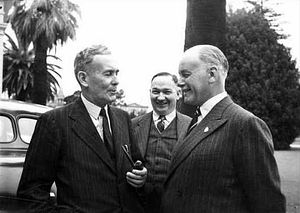The result of last year’s general election in Malaysia came under fire for controversial voting practices like malapportionment, a term in politics that means one electorate has fewer voters than another but both get equal representation in the form of an individual member of parliament. In fact, the same issues was faced by citizens in the Australian state of South Australia for decades under Premier Sir Thomas Playford. So how did the system develop? How did it get changed to give a more equal voice to all citizens? And what can Malaysia learn from this example?
Playford emerged as a political figure in the early 1930s, in the depths of the Great Depression. Unemployment and urban discontent was producing a strong swing against the Labor government of the day. Approaching the 1933 South Australian election, Playford was encouraged to follow his father’s footsteps into parliament. When a state alliance was created between the Liberal Federation Party and Country Party, forming the Liberal and Country League (LCL), victory seemed certain and Playford ran.
Ousting the widely disliked nine-year Labor government, the LCL enjoyed popular success when it became the first state in Australia to balance its budget since the onset of the Depression. However, amidst its economic successes, the LCL laid the foundation for what would become known as the Playmander – a play on the word gerrymander – which referred to the malapportionment that would keep Playford (who rose rapidly from backbencher to become premier of South Australia in 1938) in office for more than 26 years. Part of the problem was that the LCL had given too much power to rural conservatives of the former Country Party. This was, in part, a necessity if a clear, absolute majority was going to emerge from the 1933 election.
As it happens, the Malaysian argument for what became malapportionment was also one built on necessity. In the Malaysian constitution, malapportionment was almost explicitly mandated in amendments made in the 1960s due to the “special requirement” of rural electorates. Specifically, with rural areas being difficult to access and with relatively dispersed populations, the representatives of these electorates required more time, it was argued, to consult with their local communities on government matters.
This leaves the city-slickers with less of a say, and in May last year that turned a four per cent deficit in the popular vote for the incumbent Barisan Nasional (BN) party into a 20 per cent seat majority over the opposition coalition, Pakatan Rakyat (PR). Then again, it’s nothing on Playford’s 1962 election result, where the LCL won only 35 per cent of the primary vote and still managed to stay in power. As ridiculous as it is, these disasters of democracy are brought about by a few archaic, borderline-mischievous laws governing the electoral system.
While malapportionment still exists in Australia, it’s nothing like it once was. So how did democratic values triumph in an undemocratic system? Well, strictly speaking, they didn’t.
To knock down the Playmander system, Labor’s 1965 election campaign was focused entirely on winning marginal rural seats. All other seats, even the few marginal city seats, were insignificant in the big picture and thus ignored. In other words, just as Playford and pals had played the electoral system for decades, Labor had to get into the same game – dirty tactics went up against dirty tactics, and dirty tactics won.
A few years later, Labor passed sweeping legislation that recreated the electoral map and gave voters state-wide as equal a vote as possible. As the morally ambiguous adage goes, sometimes you have to get your hands dirty.
Currently, in Malaysia, the seat count for BN is 133 and for PR it is 89. What PR needs to do, therefore, is focus more on the marginal rural seats – seats like Baram in Sarawak, which BN won by only 194 votes. It doesn’t have to worry about the ultra-safe seats like Bukit Mertajam in Pulau Pinang, which it won by 43,063 votes.
While that might seem like an obvious and easy political tactic, what’s also important to consider is the overall size of each electorate. A smaller electorate means fewer marketing and advertising dollars. So while it might seem counterintuitive, campaign ringgit are better directed at Sabak Bernam in Selangor, where the government kept the seat with a majority of 1,633 votes, than it is putting effort into a seat like Segamat in Johor, where BN held on by only 1,217 votes. That’s because in Sabak Bernam there are only a total of 31,130 voters to get your message to, whereas in Segamat there are 38,857. Both have a similarly small margin, but campaigning might be more cost effective in Sabak Bernam.
That said, Johor has many marginal seats that BN only held by a few thousand votes. Considering that marketing might spill over or be dispersed among many nearby electorates within a region, it could be even more effective to focus regionally on groups of marginal seats, rather than making seat-specific campaign choices.
PR needs 12 more seats to form government at the 2018 general election. It snatched seven in 2013, and there are at least 20 seats that BN holds by a margin of less than 2,000 votes. The opposition will need to focus on these seats, especially in Johor, while making sure to defend its own 13 marginal seats which were won by less than 2,000 votes each in the last election.
Given enough political willpower and determination, 2018 could spell the end for Malaysia’s malapportionment and meltdown of democratic values. Following the example of Labor’s 1965 state election campaign in Australia, focusing intensely on marginal rural seats, will be vital to any successful overthrow of the government’s 40-year rule. True democracy in Malaysia, let’s hope, is on its way.
Tom Burns is a Melbourne-based writer who studies bioethics and neuroscience. You can follow him on Twitter @tfburns and read his blog at www.tfburns.com.































